At first glance, classical comparisons between the total radioactivity of high-level waste (HLW) and the original uranium ore might suggest that, over time, this waste will no longer require shielding. Figure 1 provides one such example [1]. It shows the total amount of radioactivity of vitrified high-level waste (VHLW) decreasing to “natural levels” within about 10 000 years and becoming negligible thereafter. However, HLW containers concentrate radioactivity in relatively compact volumes, and what counts for protection is the amount and type of radiation emitted from each individual container as a function of time [2]. Figures 2 and 3 illustrate this fact for spent fuel (SF).
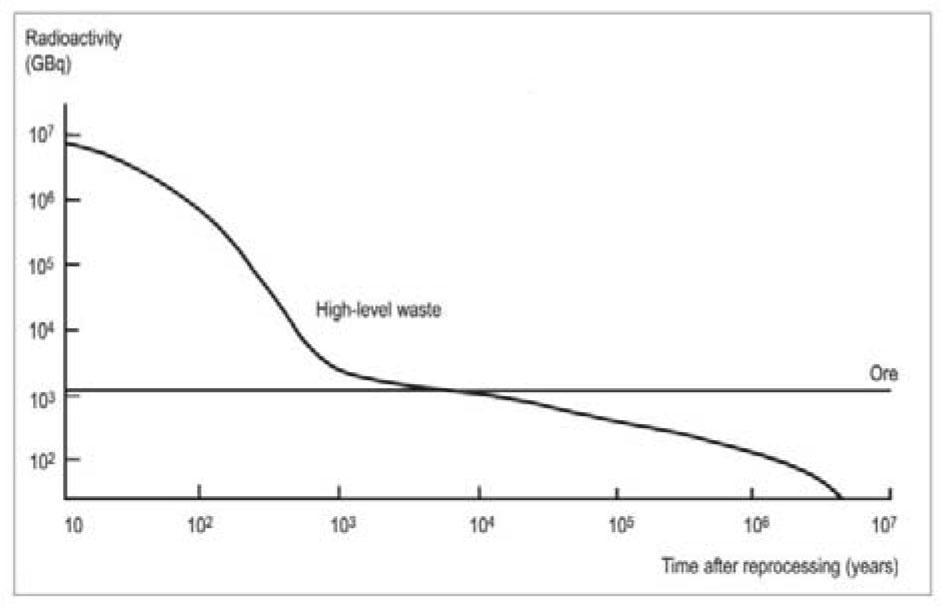
Decay of VHLW from reprocessing 1 metric ton of SF (p. 17 in Ref. [1]).
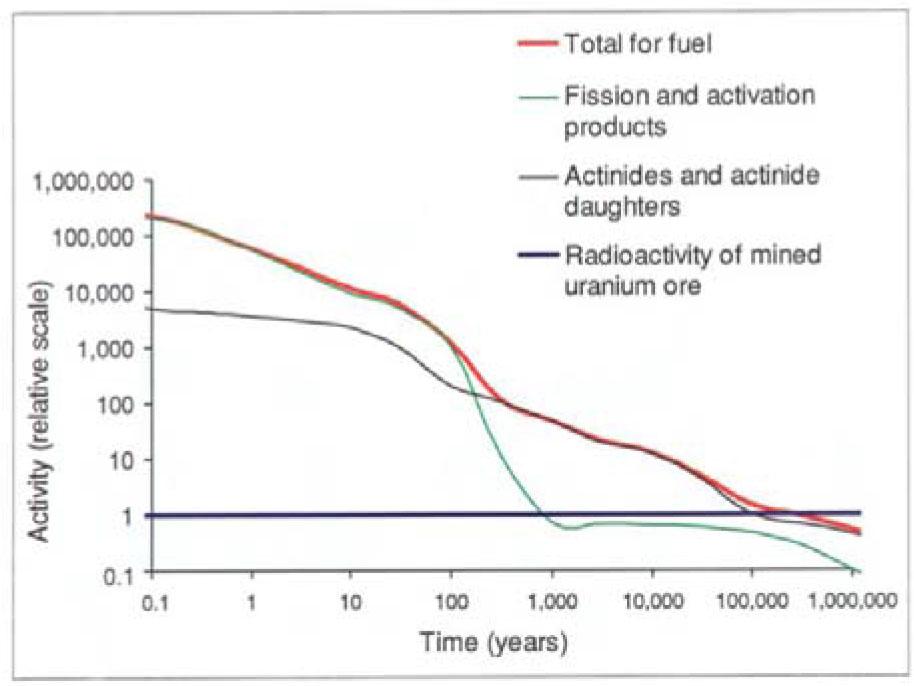
Decay of activity content of 1 metric ton of Swedish SF (p. 16 in Ref. [3]).
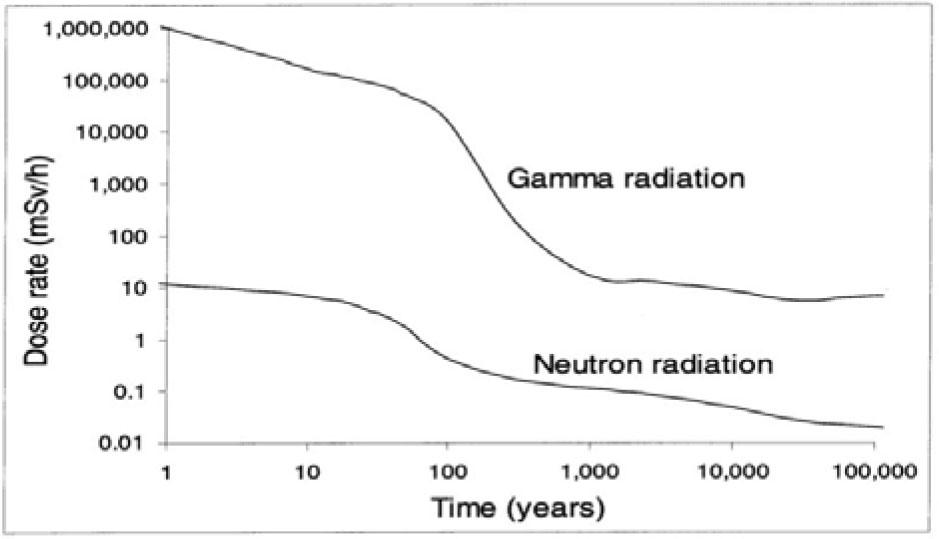
External radiation 1 m away from 1 metric ton of Swedish SF (p. 23 in Ref. [3]).
On one hand, Fig. 2 correctly shows that, by 250 000 years, the total activity of 1 metric ton of Swedish SF decays below the constant background radioactivity of the mined uranium from which it was derived. On the other hand, Fig. 3 also correctly shows that 20 000 years after discharge, the same amount of Swedish SF generates a gamma dose rate of the order of 10–20 mSv/h at 1 m distance, with no evident decrease beyond that time. This dose rate exceeds by orders of magnitudes allowable dose rates for proximity to radiation sources. It turns out that, at 100 000 years, the gamma dose rate from SF is dominated by Bi-214 in secular equilibrium with the excess U-234 in the waste [2]. While U-234 continues to decay, more Bi-214 is created by U-238 as it progresses toward secular equilibrium with its daughters. As a result, and because U-238 is the main component of SF, Bi-214 will dominate the SF dose essentially indefinitely, with values exceeding allowable dose rates for proximity or handling.
In a previous study we quantitatively demonstrated the continuing radiological hazard of HLW beyond a million years [2]. The focus of that study was on assessing the hazard by estimating the gamma dose rates. This paper builds upon, and completes, that study by taking a more tangible approach: the provision of shielding estimates. Specifically, this paper focuses on the thickness of concrete required to protect individuals and the environment from gamma radiation emitted by these wastes at and beyond a million years, without a time cutoff.
Shielding estimates convey the severity of the hazard in tangible terms. By specifying the required thickness to meet current radiation protection standards, this paper provides a different perspective on the very long-term intrinsic hazard of HLW. It also provides new insights and incentives to delve further into the future safety and design of geological repositories and more. The aim is not to be comprehensive but to pave the way for more detailed analyses of a subject that has not been addressed in the literature for these impressively long timescales, so that future decision-making in several domains is informed by consideration of these time spans. Further research and data needs are identified.
High-level waste, whether in the form of SF or VHLW from uranium fuel reprocessing, contains a mix of radionuclides with long half-lives. By 1 million years, these include the decay chains headed by Np-237 and U-238, which will be, de facto, in secular equilibrium with their daughters. As a result, all daughter isotopes, including the shorter-lived ones, will have the same activity as their parent and will remain hazardous for as long as the parent radionuclide is present, which is tens of millions of years for the Np-237 chain (half-life of 2.14 million years) and essentially indefinitely for the U-238 chain (half-life of 4.47 billion years). As gamma radiation can penetrate most materials and typically requires substantial shielding to reduce exposure to safe levels, the primary concern regarding shielding requirements is the gamma-emitting isotopes from the members of these decay chains.
A third isotopic chain is also important during the first few million years after reactor discharge. Specifically, the one headed by the excess U-234 present in the waste at reactor discharge, whose amount stabilizes after the first 1000 years, once all Pu-238 (half-life of 88 years) has decayed. Following [2], we will address the contributions of U-238 and excess U-234 separately.
An important source of information is the French Agency for Radioactive Waste Disposal (ANDRA) (Figs. 4 and 5).
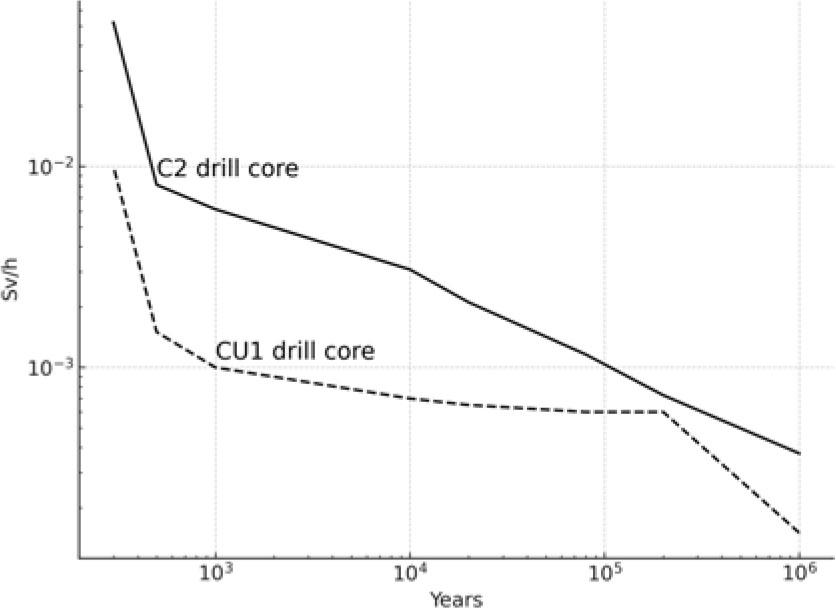
Radiological dose rate, in Sv/h, 40 cm from two French HLW drill cores. The C2 drill core is VHLW; the CU1 drill core is SF (p. 533 in Ref. [5]).
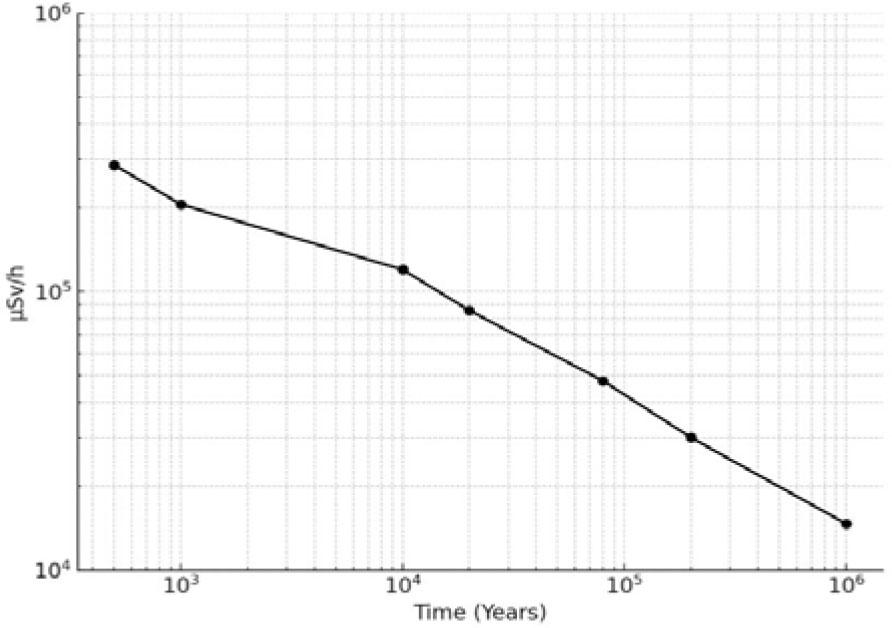
The dose rate 2 cm away from a full-size, unshielded C2 cylinder as a function of time (Source, ANDRA).
Figure 4 plots external doses 40 cm away from drill cores extracted during potential intrusion episodes into a geological repository. CU1 represents spent UOX fuel, while C2 represents VHLW. The CU1 drill core consists of two cylinders, each 21.4 cm in height and 10 cm in diameter, laid out on the same longitudinal axis with a gap in between; the C2 drill core is a single cylinder of 40-cm height and 10-cm diameter. The drill cores capture the nuclear material as one solid piece, without counting any potential residual shielding. Using the inverse distance approximation of cylindrical geometry [4], the contact dose rates of the C1 and C2 drill cores extrapolate to roughly 2 mSv/h and 5 mSv/h, respectively, 2 cm from the surface at 1 million years.
Figure 5 plots the contact dose rate at 2 cm from a full-size C2 cylinder block of 120-cm height and 42-cm diameter. At 1 million years, its value is 14.7 mSv/h.
Concerning full-size SF, Table 1 reports computed and extrapolated dose rates from a Pollux cask loaded with eight PWR fuel assemblies, or about 4 tons of UO2 fuel, neglecting the shielding of the cask.
Gamma dose rate (mSv/h) at three distances from a Pollux-8 cask loaded with eight PWR UO2 fuel assemblies, neglecting the shielding of the cask [2]
| Decay time (million years) | Surface (4 cm) | Surface (2 cm extrapolated) |
|---|---|---|
| 1 | 6.6 | 13.1 |
| 10 | 2.8 | 5.5 |
| 100 | 2.7 | 5.4 |
| 1000 | 2.3 | 4.6 |
For estimating the relevant shielding thicknesses, we need reference radiation protection criteria. We will be using two criteria: (1) 0.02 mSv/h, which is the maximum allowable to by a member of the public in an unrestricted area in any 1 h according to the regulations [6] of the United States Nuclear Regulatory Commission (USNRC). This we call the “proximity criterion”, DP; and (2) the International Commission on Radiation Protection’s (ICRP) maximum tolerable limit of 20 mSv/year for the dose rate to any individual from pre-existing radiological situations [7]. On an hourly basis, this limit reduces to 0.002 mSv/h. This we call the “tolerability criterion”, DT.
All the surface dose rates reported above at 1 million years for either VHLW or SF exceed both the USNRC’s proximity criterion and the ICRP’s tolerability criterion. Therefore, shielding will be needed for the nuclear material in each individual container or drill core. The necessary thickness of the shield, υ, can be calculated using the classical shielding formula [4]:
Because of secular equilibrium, D(t) takes up the form:
Mathematical manipulation allows υ to be expressed as the sum of two terms: one representing the thickness of the shield at 1 million years and the other representing a correction that increases with time. Specifically,
Interestingly, υ is linearly dependent on half-value layer and, hence, energy, while it is only logarithmically sensitive to the starting dose rate, S.
For calculating υ238, υ234, and υ237, we need to input into Eq. (4) the dose rates from the U-238, the excess U-234, and the Np-237 chains at 1 million years, respectively. For the nuclear material in the waste containers and drill cores above, these values – S238, S234, and S237 – are known [2] and are reported in Table 2. For CU1, we used the percentages calculated in Ref. [2] for the unshielded assemblies in the Pollux-8 cask. Table 3 reports the decay constants for each chain.
Dose rate (mSv/h) 2 cm from reference unshielded VHLW and SF at 1 million years [2]
| Surface dose rates | C2 VHLW full-size | C2 VHLW drill core | 8 PWR SF assemblies | CU1 SF drill core |
|---|---|---|---|---|
| S238 | 0.09 | 0.0032 | 5.4 | 0.82 |
| S234 | 0.18 | 0.0068 | 3.54 | 0.54 |
| S237 | 14.42 | 7.45 | 4.2 | 0.64 |
| Total | 14.69 | 4.46 | 13.14 | 2.00 |
Decay constants in per-million-year units
| Chain | λ |
|---|---|
| U-238 | 1.55 × 10−5 |
| Excess U-234 | 2.82 |
| Np-237 | 0.324 |
Finally, appropriate values are needed for the reference gamma energies, E, for each chain. All chains emit a wide range of gamma photons, spanning from lower to higher energy gamma rays. As explained in the Appendix, we take a prudent yet not overly conservative approach, which results in E = 1.76 MeV for the U-238 and the excess U-234 chain, and E = 1.2 MeV for the Np-237 chain. More conservative energy values, reported in the Appendix, could have been chosen as well. To this effect, it is helpful to observe that the ratio between the thickness of the shield based on different energy values obeys the relationship:
The higher energy values identified in the Appendix would result in a concrete shield roughly twice as thick for the Np-237 cases and 33% thicker for the uranium cases.
Tables 4 and 5 present the required thickness of concrete shielding at 1 million years for each radioactive chain, based on the proximity and the tolerability criterion, respectively. Since the U-238 and excess U-234 chains share the same energy spectrum, the concrete thickness is also calculated using the combined dose rates from both chains. The tables highlight the largest required thicknesses in bold, which serve as the protection reference at 1 million years. Italicized values represent thicknesses predicted for later periods, based solely on U-238.
Calculated shield thicknesses at 1 million years depending on each nuclear chain and using the proximity criterion. In bold are the required envelope thicknesses for each waste form. These values will decrease in time to reach the values for U-238, reported in italics
| Surface dose rates | C2 VHLW full-size | C2 VHLW drill core | 8 PWR SF assemblies | CU1 SF drill core |
|---|---|---|---|---|
| S238 | 16.6 | – | 61.9 | 41.1 |
| S234 | 24.3 | – | 57.3 | 36.5 |
| S238 + S234 | 28.8 | – | 67.5 | 46.7 |
| S237 | 53.5 | 48.1 | 43.5 | 28.2 |
Dp = 0.02 mSv/h.
Calculated shield thicknesses at 1 million years depending on each nuclear chain and using the tolerability criterion. In bold are the required envelope thicknesses for each waste form. These values will decrease in time to reach the calculated for U-238, reported in italics
| Surface dose rates | C2 VHLW full-size | C2 VHLW drill core | 8 PWR SF assemblies | CU1 SF drill core |
|---|---|---|---|---|
| S238 | 42.1 | 5.2 | 87.4 | 66.6 |
| S234 | 49.8 | 13.5 | 82.7 | 61.9 |
| S238 + S234 | 54.3 | 17.8 | 93.0 | 72.2 |
| S237 | 72.2 | 66.9 | 62.2 | 46.9 |
DT = 0.002 mSv/h.
Under the USNRC proximity criterion, the required shielding at 1 million years ranges from 53.5 cm for the C2 full-size waste form to 67.5 cm for the Pollux-8 cask assemblies. Under the ICRP tolerability criterion, these values increase to 72.2 cm and 93 cm, respectively.
As expected, the required thicknesses are larger under the smaller criterion, and they are larger for the full-size waste forms than for the drill cores. However, relatively small drill cores will still require protection that is comparable to their much larger, intact counterparts, which is consistent with the findings in Ref. [2]. Additionally, as expected [2], at 1 million years, the Np-237 series dominates for VHLW, while the sum of the U-238 and excess U-234 series dominates for SF.
According to Tables 4 and 5, the U-238 + U-234 shielding requirements dominate both the unshielded Pollux-8 cask (eight fuel assemblies) and the CU1 drill core at 1 million years. The required thicknesses are 67.5 cm and 46.7 cm, respectively, with the proximity criterion, and 93.0 cm and 72.2 cm with the tolerability criterion.
By 2.5 million years, the contribution of U-234 will have decayed, leaving U-238, with its 4.47-billion-year half-life, as the primary concern. At this point, the required shielding will remain nearly constant indefinitely, matching the values for U-238 at 1 million years. Beyond 2.5 million years, the unshielded Pollux-8 cask will require 61.9–87.4 cm of concrete, depending on the criterion (proximity of the USNRC or tolerability of the ICRP). For the CU1 drill core, the requirement ranges from 41.1 cm to 66.6 cm. These values are considered prudent but not overly conservative, as explained in the Appendix.
All uranium fuels are essentially pure UO2, which is a ceramic compound of the same density across all fuels and resulting, for U-238, in the same secular equilibrium composition at and beyond a million years. Thus, although not necessarily bounding cases, the above results are representative of most LWR or CANDU spent fuel, as well as of uranium fuels from new-generation reactors. Additionally, the CU1 drill core and the Pollux-8 assemblies span a large range of SF waste amounts and geometries, which should encompass most SF encapsulation situations. (1)
For the unshielded full-size C2 waste cylinder, Tables 4 and 5 show that the required concrete thickness at 1 million years is driven by the Np-237 decay chain, ranging from 53.5 cm, with the proximity criterion, to 72.2 cm, with the tolerability criterion. Since Np-237 has a half-life of 2.14 million years, these requirements decrease over time until they meet the U-238-imposed requirements of 16.6–42.1 cm, which remain constant indefinitely. This cross-over occurs at 30.8 million and 25.3 million years, respectively.
For the C2 drill core, the required thickness at 1 million years also depends on Np-237, ranging between 48.1 cm and 66.9 cm. The corresponding U-238-based requirements are either zero (as the proximity criterion is met) or 5.2 cm. The proximity criterion requirement of 48.1 cm at 1 million years decreases to zero by 39.8 million years. Under the tolerability criterion, the 66.9 cm requirement reduces to 5.2 cm by 50.7 million years, then remains constant. These values are considered prudent but not overly conservative, as explained in the Appendix.
C2 is a future glass waste form within a larger family of vitrified waste forms of the same size, weight, and glass formulation in France [2, 5]. These waste forms are designated generically as COG-X, where X refers to a specific mix of radionuclides. Figure 6 plots the accumulated dose after 10-min exposure at 40 cm from drill cores of various unshielded COG-X containers. Each drill core is a 40-cm long cylinder of 10-cm diameter.

Accrued, external dose from drill cores of several kinds of present and future French VHLW after a 10-min exposure, 40 cm from the drill core, and as a function of time (p. 352 in Ref. [9]).
At a million years, the reported doses vary between 8 Sv and 100 Sv, roughly, which corresponds to dose rates, 2 cm from the surface, between 0.1 mSv/h and 3 mSv/h. Figure 6 also reports the numbers of COG-X waste containers foreseen to be produced in the French program. We observe that the COG-X do not differ substantially from the C2 drill core in terms of surface dose rate. Besides the thickness of the shield, Eq. (4), is only logarithmically sensitive to dose rate. Furthermore, all COG-X waste forms contain higher concentrations of U-238 than C2 [10, 11].
We can thus conclude that all unshielded COG-X waste cylinders, of which there will be >50 000, will need a protective concrete shield of the order of 52–73 cm at 1 million years, depending on the protection criterion used. These requirements will decrease to roughly 17 cm and 42 cm, starting either at 30.8 or at 25.3 million years, respectively, and will continue practically indefinitely.
At the same time, depending on the applicable protection criterion, relatively small volumes of VHLW, e.g., drill cores of 40-cm height and 10-cm diameter, will need shielding either indefinitely or for several tens of millions of years.
Shielding thickness is linearly dependent on the reference gamma energy of each decay chain. In this paper, we have used a screening approach that avoids overly conservative assumptions and provides a solid and prudent basis for initial shielding estimates. Future refinements may involve integrating over the entire gamma energy spectrum, accounting for the probability of emission of each photon energy as part of international discussions and benchmarking exercises. In all cases, it will be important to document the assumptions made.
This analysis shows that both SF and VHLW require equivalent shielding to several tens of centimeters of concrete and that this requirement remains largely constant once the U-238 chain becomes dominant after the decay of the excess U-234 and of Np-237, respectively. The U-238, Np-237, and U-234 loadings of VHLW should be specified as a matter of routine. As observed in Ref. [2], this is not yet the case today.
Finally, while we have focused on HLW, it is worth performing similar analyses for long-lived medium-level wastes (LLMLW). LLMLW may exhibit higher U-238 loadings than some vitrified HLW from SF reprocessing, resulting in larger ultimate dose rates. Reference [11] mentions that alpha-contaminated waste from MOX fuel fabrication plants will be conditioned using incineration, fusion, and vitrification techniques that are currently under study at the French Commissariat à l’Energie Atomique. The French EdF-120 waste form, of which there will be 100 containers [9], shows dose rates similar to COG-830 over a million years. The latter is the highest emitter of all French COG-X VHLW (see Fig. 6).
This paper highlights that high-level waste (HLW), including spent nuclear fuel (SF) and VHLW, remains a gamma radiation hazard essentially indefinitely. This paper’s quantitative analysis demonstrates that robust shielding – equivalent to several tens of centimeters of concrete at 1 million years – is required to meet modern radiation protection standards for both SF and VHLW.
For SF, after the decay of the excess U-234 chain in about 2.5 million years, the U-238 continues as the dominant chain, and the shielding requirements remain high and largely constant. For VHLW, the U-238 becomes dominant beyond 25 million years. By then the Np-237 series will have decayed and the shielding requirement for VHLW will be constant but much reduced vis-à-vis at a million years. These results provide an additional perspective on a hazard that endures beyond the timescales of current safety analyses and that has been overlooked so far in discussions of the choice of fuel cycle and in the design of geological repositories.
Geological barriers in HLW repositories are expected to offer adequate protection from direct exposure to the waste. However, as geomorphological changes inevitably occur in most geological regions and amplify over millions and millions of years, it is not a certainty that this protection may always be sufficient. Moreover, protection must be ensured from each individual waste container and any fragments thereof, whereas, over vast timescales, it is highly likely that episodes of human- or biota-and-waste interaction will occur multiple times. The “Joint Convention on the Safety of Spent Fuel Management and on the Safety of Radioactive Waste Management”, signed by over 90 countries [12], demands that potential hazards are addressed throughout the extensive risk horizon, with no time cutoff.
The present first-of-a-kind analysis paves the way for further research and international cooperation, particularly in refining shielding estimates by incorporating the entire energy spectrum of emitted gamma rays in greater detail. Attention is also called to the potential, long-term gamma hazard from long-lived medium-level wastes, especially those with highest U-238 loadings.
For instance, the Swedish KBS-3 disposal-containers include either 4 PWR or 12 BWR fuel assemblies, amounting to approximately 2 metric tons of uranium per container (p. 169 in Ref. [8]).